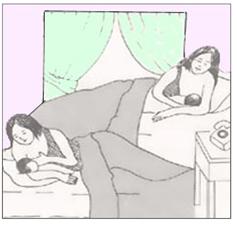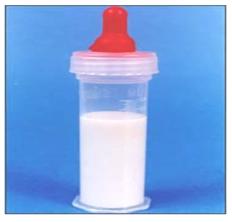미숙 신생아에게 모유수유나 인공영양을 먹일 때, Breastfeeding or formula feeding for premature infants
(Please visit www.drleepediatrics.com – Chapter 5, Formula, Milk, Weaning, Vitamin, Protein, Carbohydrate, Fat or 제 5권 인공영양,우유, 이유, 비타민, 미네랄, 단백질, 탄스화물, 지방웹사이트)

▴ 사진 4-9. 크고 건강한 미숙 신생아들에게는 모유를 수유하는 방법은 만삭 신생아에게 모유를 수유하는 것과 거의 같게 할 수 있다. Copyright ⓒ 2011 John Sangwon Lee, MD., FAAP

▴ 사진 4-10. 아주 작은 미숙 신생아들에게 인공영양이나 짠 모유를 먹일 때 이런 종류의 특수 인공영양 우유병을 이용할 수 있다. Copyright ⓒ 2011 John Sangwon Lee, MD., FAAP
- 출생 시 체중이 2~2.5kg이거나 그 이상 되는 건강하고 큰 미숙 신생아들에게는 모유를 수유하는 방법이나 인공영양을 먹이는 방법은 만삭에 태어난 정상 신생아들에게 모유나 인공영양을 먹이는 방법과 별로 다른 것이 없다.
- 일반적으로 임신 35~37주에 태어난 미숙 신생아가 출생 후 대체로 건강하면 바로 모유수유를 할 수 있다. 또는 바로 인공영양을 먹일 수 있다.
- 그러나 출생 시 체중이 2kg이거나 그보다 더 작은 미숙 신생아들이나 저체중 신생아들에게 모유수유를 하거나 인공영양을 먹이는데 더 많은 피딩(Feeding) 기술(식이기술)과 육아 지식이 요한다.
- 때로는 소아청소년과 전문의나 간호사의 도움을 받고 인공영양을 먹이어야 할 때도 있다.
- 임신 35~37주경 태어난 미숙 신생아들 중 일부는 모유를 보통으로 잘 수유할 수 없을 때도 있다.
- 이때는 미숙 신생아 스스로 엄마의 젖꼭지를 잘 빨아 모유를 잘 먹을 수 있을 때까지 손이나 착유펌프로 젖을 짜서 우유병으로 모유를 먹일 수 있다.
- 게다가 출생 시 체중이 1.5kg 이하 되는 아주 작은 미숙 신생아들의 대부분은 엄마의 젖꼭지나 우유병 꼭지를 제대로 빨 수 있는 힘도 없다.
- 우유병 꼭지의 구멍이 더 크게 뚫린 특수 미숙 신생아용 우유병 꼭지로 인공영양을 먹일 때도 있다. 그 보다 더 쉽게 먹을 수 있게 만든 미숙아 전용 우유병과 우유병 꼭지를 이용해 모유나 인공영양을 먹이기도 한다.
- 때로는 손이나 착유펌프로 짠 모유나 인공영양을 피딩 튜브(튜브 영양법)를 이용해서 아주 작은 미숙신생아들에게 먹이기도 하고 짠 모유를 특별히 만든 우유병 꼭지를 이용해서 특별한 우유병으로 먹이기도 한다.
- 모유는 소화가 비교적으로 잘 되고 감염병을 예방하는 데도 더 좋기 때문에 가능한 한 미숙 신생아들에게 모유수유를 전적으로 하는 것이 좋다.
- 대부분의 미숙 신생아들은 만삭 신생아들에 비해 젖을 먹은 후나 인공영양을 먹은 후 잘 넘길 수 있고 때로는 생리적 위식도 역류가 있어 잘 토할 수 있다.
또한 구토 물이 기관이나 기관지, 폐 속으로 흡인되어 흡인성 폐렴이 더 쉽게 생길 수 있다. 이런 저런 이유로 미숙 신생아들을 양호하는 데는 더 많은 사랑과 인내, 관심과 육아지식이 더 많이 필요하다. 인공영양의 일정량의 칼로리 양에 따른 종류(Kinds of infant formula by calories) 참조
출처 및 참조 문헌 Sources and references
- NelsonTextbook of Pediatrics 22ND Ed
- The Harriet Lane Handbook 22ND Ed
- Growth and development of the children
- Red Book 32nd Ed 2021-2024
- Neonatal Resuscitation, American Academy Pediatrics
- www.drleepediatrics.com 제5권. 인공영양, 우유, 이유식, 비타민, 미네랄, 단백질, 탄수화물, 지방
-
Childhood Emergencies in the Office, Hospital and Community, American Academy of Pediatrics
-
Emergency Medical Service for Children, By Ross Lab. May 1989. p.10
-
Emergency care, Harvey grant, and Robert Murray
-
Emergency Care Transportation of Sick and Injured American Academy of Orthopaedic Surgeons
-
Emergency Pediatrics A Guide to Ambulatory Care, Roger M. Barkin, Peter Rosen
-
Immediate care of the acutely ill and injured, Hugh E. Stephenson, Jr
-
The Critically Ill Child, Diagnosis and Management, Edited by Clement A. Smith
-
Emergency Medical Services for Children: The Role of the Primary Care Provider, America Academy of Pediatrics
-
Quick Reference To Pediatric Emergencies, Delmer J. Pascoe, M.D., Moses Grossman, M.D. with 26 contributors
-
Manual of Emergency Care 응급환자관리 정담미디어
-
소아가정간호백과–부모도 반의사가 되어야 한다, 이상원
-
Neonatal Resuscitation American heart Association
-
Neonatology Jeffrey J.Pomerance, C. Joan Richardson
-
Pediatric Resuscitation Pediatric Clinics of North America, Stephen M. Schexnayder, M.D.
-
Pediatric Critical Care, Pediatric Clinics of North America, James P. Orlowski, M.D.
-
Preparation for Birth. Beverly Savage and Dianna Smith
- The Johns Hopkins Hospital, The Harriet Lane Handbook, 18th edition
-
Red book 29th-31st edition 2021
-
Nelson Text Book of Pediatrics 19th-21st Edition
-
Infectious disease of children, Saul Krugman, Samuel L Katz, Ann A. Gershon, Catherine Wilfert
-
The Harriet Lane Handbook 19th Edition
-
소아과학 안효섭 외 대한교과서
-
제1권 소아청소년 응급의료 참조문헌과 출처
-
Other
- Copyright ⓒ 2015 John Sangwon Lee, MD., FAAP
- “부모도 반의사가 되어야 한다”-내용은 여러분들의 의사로부터 얻은 정보와 진료를 대신할 수 없습니다.
- “The information contained in this publication should not be used as a substitute for the medical care and advice of your doctor. There may be variations in treatment that your doctor may recommend based on individual facts and circumstances. “Parental education is the best medicine.”